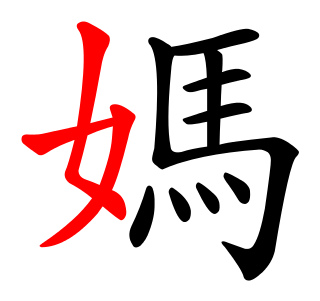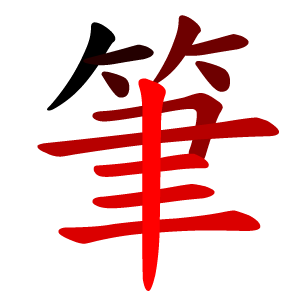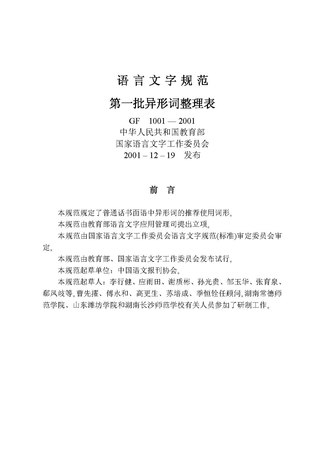
A Chinese radical or indexing component is a graphical component of a Chinese character under which the character is traditionally listed in a Chinese dictionary. This component is often a semantic indicator similar to a morpheme, though sometimes it may be a phonetic component or even an artificially extracted portion of the character. In some cases the original semantic or phonological connection has become obscure, owing to changes in character meaning or pronunciation over time.
Simplified Chinese characters are one of two standardized character sets widely used to write the Chinese language, with the other being traditional characters. Their mass standardization during the 20th century was part of an initiative by the People's Republic of China (PRC) to promote literacy, and their use in ordinary circumstances on the mainland has been encouraged by the Chinese government since the 1950s. They are the official forms used in mainland China and Singapore, while traditional characters are officially used in Hong Kong, Macau, and Taiwan.

Stroke order is the order in which the strokes of a Chinese character are written. A stroke is a movement of a writing instrument on a writing surface.

Mojikyō, also known by its full name Konjaku Mojikyō, is a character encoding scheme. The Mojikyō Institute, which published the character set, also published computer software and TrueType fonts to accompany it. The Mojikyō Institute, chaired by Tadahisa Ishikawa (石川忠久), originally had its character set and related software and data redistributed on CD-ROMs sold in Kinokuniya stores.

Project 211 was a higher education development and sponsorship scheme of the Chinese central government for preparing approximately 100 universities for the 21st century, initiated in November 1995. There were 115 universities and colleges selected to be part of this program.

The debate on traditional Chinese characters and simplified Chinese characters is an ongoing dispute concerning Chinese orthography among users of Chinese characters. It has stirred up heated responses from supporters of both sides in mainland China, Hong Kong, Macau, Taiwan, and among overseas Chinese communities with its implications of political ideology and cultural identity. Simplified characters here exclusively refer to those characters simplified by the People's Republic of China (PRC), instead of the concept of character simplification as a whole. The effect of simplified characters on the language remains controversial, decades after their introduction.
Extended shinjitai is the extension of the shinjitai. They are the simplified versions of some of the hyōgaiji. They are unofficial characters; the official forms of these hyōgaiji are still kyūjitai.

Radical 140 or radical grass (艸部) meaning "grass" is one of 29 of the 214 Kangxi radicals that are composed of 6 strokes. It transforms into 艹 when appearing at the top of a character or component. In the Kangxi Dictionary and in modern standard Traditional Chinese as used in Taiwan, Hong Kong and Macau, 艹 consists of four strokes, while in Simplified Chinese and modern Japanese, 艹 consists of three strokes.
The development of Singapore's Chinese characters can be divided into three periods.

Xiandai Hanyu Cidian, also known as A Dictionary of Current Chinese or Contemporary Chinese Dictionary, is an important one-volume dictionary of Standard Mandarin Chinese published by the Commercial Press, now into its 7th (2016) edition. It was originally edited by Lü Shuxiang and Ding Shengshu as a reference work on modern Standard Mandarin Chinese. Compilation started in 1958 and trial editions were issued in 1960 and 1965, with a number of copies printed in 1973 for internal circulation and comments, but due to the Cultural Revolution the final draft was not completed until the end of 1977, and the first formal edition was not published until December 1978. It was the first People's Republic of China dictionary to be arranged according to Hanyu Pinyin, the phonetic standard for Standard Mandarin Chinese, with explanatory notes in simplified Chinese. The subsequent second through seventh editions were respectively published in 1983, 1996, 2002, 2005, 2012 and 2016.
The Table of Indexing Chinese Character Components is a lexicographic tool used to order the Chinese characters in mainland China. The specification is also known as GF 0011-2009.

The promotion of Standard Chinese is a campaign by the government of China, with the stated goal being to facilitate easier communication throughout the country, which has historically spoken many mutually unintelligible varieties of Chinese, as well as non-Sinitic languages. Currently, the promotion of Standard Chinese is organized by the State Language Work Committee, a regulatory agency within the Chinese government.

The First Series of Standardized Forms of Words with Non-standardized Variant Forms published on December 19, 2001 and officially implemented on March 31, 2002, is a Standard Chinese style guide published in China. It contains 338 Standard Chinese words that have variant written forms. In the First Series, one of the variant written forms for each word was selected as the recommended standard form.
Cantonese Bopomofo, or Cantonese Phonetic Symbols is an extended set of Bopomofo characters used to transcribe Yue Chinese and, specifically, its prestige Cantonese dialect. It was first introduced in early 1930s, and then standardized in 1950. It fell into disuse along with the original Bopomofo for Mandarin Chinese in the late 1950s.
Modern Chinese characters are the Chinese characters used in modern languages, including Chinese, Japanese, Korean and Vietnamese. Chinese characters are composed of components, which are in turn composed of strokes. The 100 most frequently-used characters cover over 40% of modern Chinese texts. The 1000 most frequently-used characters cover approximately 90% of the texts. There are a variety of novel aspects of modern Chinese characters, including that of orthography, phonology, and semantics, as well as matters of collation and organization and statistical analysis, computer processing, and pedagogy.
The goal of Chinese character rationalization or Chinese character optimization is to, in addition to Chinese character simplification, optimize the Chinese characters and set up one standard form for each of them.
A Chinese character set is a group of Chinese characters. Since the size of a set is the number of elements in it, an introduction to Chinese character sets will also introduce the Chinese character numbers in them.
The State Language Commission of China, formerly known as the Chinese Character Reform Committee, is a national bureau under the management of the Ministry of Education of the People's Republic of China. It is mainly responsible for the standardization of national languages, and for implementing the policies and laws of the State Council on languages.
Language Press, formerly the Chinese Character Reform Press, is a publishing company in the People's Republic of China. Its business includes educational publishing, dictionary and academic works publishing, popular culture book publishing and digital publishing.











